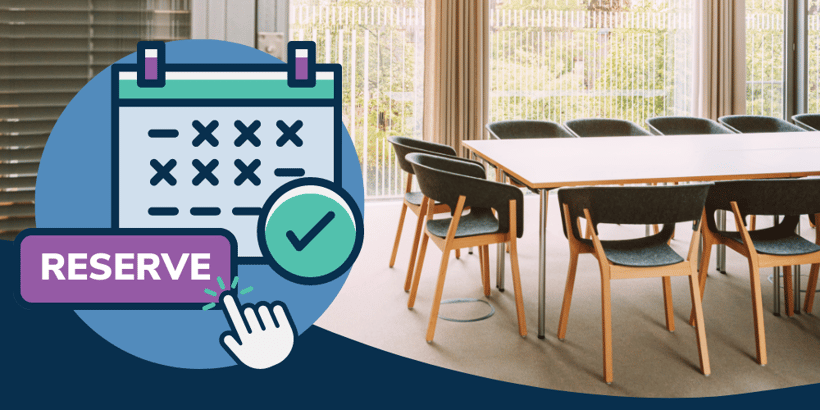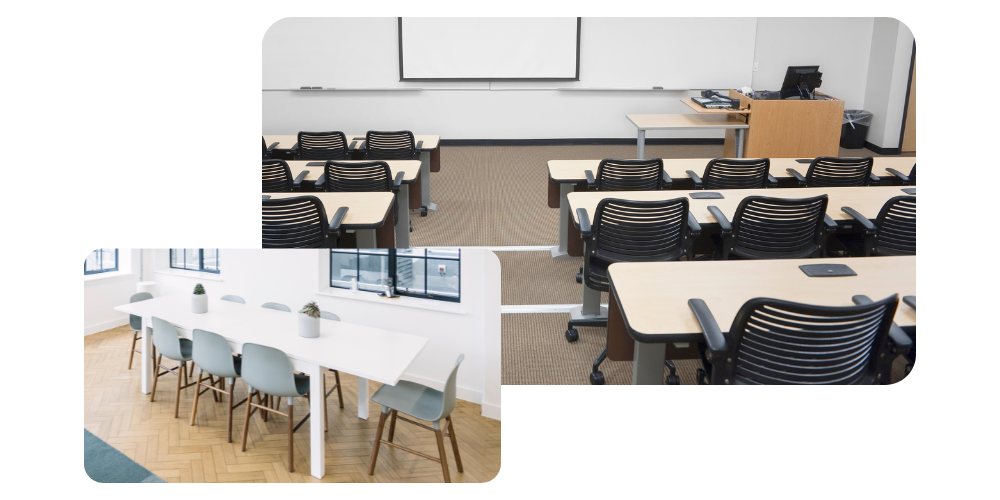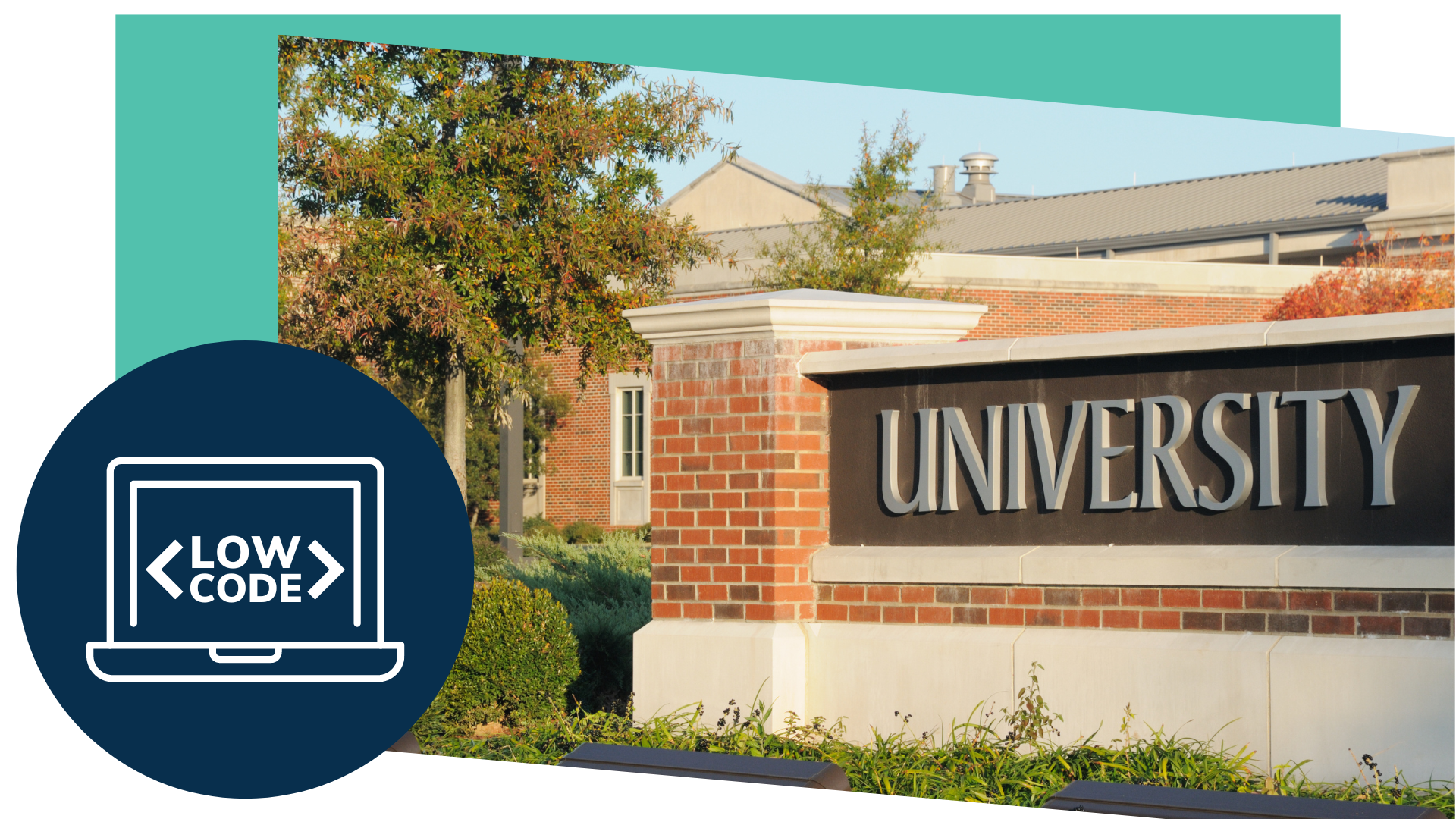
Space management refers to optimizing productivity within an organization by maximizing the efficiency of space utilization. Space management strategies provide a framework for assessing the availability of space, planning resource allocation, and ensuring that current space utilization practices support an entity’s objectives and goals.
Without an effective space management strategy in place, an organization will experience a host of logistical challenges. Some spaces may be underutilized, whereas others may be crowded or overused, causing friction between various teams and hindering collaboration.
All types of facility spaces should be managed with a cohesive plan, including:
- Office buildings
- Warehouses
- Retail stores
- Higher learning institutions
Historically, facility space management has been especially challenging for higher education organizations, as the institution’s leadership is tasked with managing various spaces while juggling the needs of dozens of faculty members and thousands of students.
Fortunately, higher education facilities can simplify this task and optimize space utilization by leveraging facility space management software.
Facility space management in higher education
There are numerous challenges associated with managing facility spaces in a higher education setting. Most notably, these learning institutions are responsible for managing a huge diversity of spaces, including:
- Classrooms
- Labs
- Study rooms
- Residence halls
- Student centers
- Libraries
- Parking spaces
- Fitness centers
- Conference rooms
When creating space management strategies, the institution’s leadership must ensure that they meet the needs of faculty, student organizations (i.e., sports teams and recreational groups), individual students, and entire classes or programs.
The process of space management in higher education is further complicated because these institutions must also manage an inventory of shared and rentable assets, including A/V equipment, laptops, tablets, and other devices.
The organization must ensure that the right assets are available and deployed to the appropriate spaces or groups and must frequently allocate staff to help set up equipment for the groups that reserved it.
How to implement effective facility space management in higher education
Creating winning space management strategies in higher education requires a systematic approach. When creating or revamping a space management plan, organizational leaders should:
1. Identify and analyze the needs of the facility and its users
Step one is to figure out how many different groups, professors, classes, or programs need access to space and equipment. In other words, who is using what, and when?
Once organizational leaders better understand their user base, they should then conduct an assessment of available resources. During this assessment, organizational leadership should identify any potential deficiencies.
For example, if a higher education institution plans to offer 10 science courses that include a lab component during a single semester but only have one serviceable lab, scheduling issues are bound to arise. In this instance, the institution may need to invest in a second lab or reschedule some courses for the following semester.
2. Develop a space utilization plan that factors in fluctuating demand throughout the academic calendar
The next step involves the development of a space utilization plan, which must account for fluctuating demand throughout the academic calendar.
For instance, when several teams’ sports seasons overlap in late fall or early spring, the demand for the fitness center and the gym will be at its peak. As such, organizational leaders must take a proactive approach to space management and start looking for potential scheduling conflicts so they can be quickly remedied.
The space utilization plan must address spikes in demand for other types of space. This may include the library, labs, conference rooms, and even parking spaces. Ideally, space management strategies will also include a future demand planning component.
Demand planning will help organizational decision-makers continue to meet the needs of faculty and students as the institution grows.
3. Implement a space management system
Having a great plan is only part of the equation. Next, organizational leaders will need to implement a space management system to support the strategy they’ve devised. The space management system may entail software like a class scheduling platform, room reservation technology, or some combination of the two.
Space management systems vary greatly in terms of sophistication, usability, and other qualities. With that in mind, higher learning institutions should seek a solution that was purpose-built for educational organizations.
Using a generic, off-the-shelf solution might help simplify space management, but it won’t optimize the allocation of available facility resources as effectively as an industry-specific platform.
4. Utilize technology to optimize space usage
To truly optimize space usage, higher education institutions should implement custom facility space management software.
Such a solution can provide real-time insights into the status of all spaces and AV resources. Facility space management software can streamline scheduling tasks, prevent human errors like double booking, and help the university precisely track space usage.
Higher education institutions can further enhance space management by deploying internet of things (IoT) sensors.
These sensors can be used to track the status and location of AV equipment or monitor the state of available spaces. Using IoT devices like smart thermostats can also enhance space management by enabling facility leaders to automatically adjust temperatures when rooms are in use and minimize HVAC usage when they’re not.
Using technology to streamline facility space management
Facility space management software is designed to streamline the process of finding, renting, scheduling, and monitoring space usage on your campus.
The best facility space management software solutions also provide advanced reporting to track usage trends, identify which resources are in high demand, predict future demand, and meet the evolving needs of faculty and students.
Investing in the right software can turn space management into an organizational strength that enhances the student experience and minimizes friction between faculty members and departments.
Benefits of using space management software
There are numerous advantages of levering the right facility space management software. By implementing such a solution, you’ll gain instant access to the following:
1. Better visibility
The key benefit associated with facility space management software is enhanced visibility.
Put simply, a solution for higher education institutions will provide facility staff with an administrative-level bird's eye view of all reservable campus spaces, including classrooms, labs, library meeting rooms, and more. These users can configure space availability and make scheduling conflicts a thing of the past.
Facility space management software also increases visibility for end users, such as students and faculty, because they can easily see what spaces are available and book the desired room or area using an intuitive interface.
2. Real-time data
Booking a space using traditional processes is often tedious and sometimes downright frustrating.
A faculty member has to contact the person tasked with scheduling spaces. Then, that person has to verify that the space is available and hope it wasn’t accidentally double-booked. Facility space management software simplifies this process by providing schedulers with real-time data.
The technology takes the guesswork out of scheduling classrooms, labs, and other spaces. When students or faculty members book a space with modern software, they can be confident that it will be available when they arrive at the scheduled date and time.
3. Actionable reporting
Facility space management software provides robust reporting tools that administrators can leverage to gain meaningful insights into utilization through comprehensive and eye-opening reports about current utilization rates or historical usage trends. These reports can help administrators predict future demand or pinpoint underuse issues.
For instance, let’s say you have three conference spaces located at different points across the campus. After generating a utilization report, you determine that two are almost always booked, but the third is rarely used.
With this insight, you can survey users and determine why the third space is used so much less. You may find that the layout isn’t conducive to your faculty’s needs and decide to revamp the lab or replace the existing furniture or equipment with modern alternatives.
4. Automation
Managing facility space at a larger higher education institution is a complex, labor-intensive task. Facility space management software can make things much easier by providing powerful higher education automation tools and self-service solutions.
These tools can automate processes like scheduling, notifying users of their upcoming time slot, and tracking which spaces are currently available. Empowering students and faculty with self-service tools will further reduce the burden on your administrative staff and give them more time to engage in dynamic tasks.

Room reservation systems
Let’s look at a detailed example of the challenges associated with managing room reservations on your campus. Specifically, these issues can arise when doing something as simple as reserving classroom space for a school club’s meetings or events.
We’ll examine four hurdles you likely encounter on a regular basis and outline how facility space management software can help you overcome each of these challenges.
Challenge #1: Complex scheduling requirements
As you’re no doubt aware, managing space scheduling at a higher education facility can be incredibly challenging.
One of the things that makes it so difficult is that the demand for space on a college campus is constantly in flux. For example, you may experience low demand the week after a semester ends and peak demand during final exam periods.
During lulls in demand, ensuring that your space is being used efficiently can be tricky. On the flip side, you may struggle to get staff and students what they need during periods of peak demand.
Facility space management software can help you automate scheduling by allowing users to easily request and reserve spaces. Faculty members can even set up recurring reservations if they need a specific space throughout a term.
The platform will automatically track existing reservations and take the academic calendar into account to prevent double bookings.
Challenge #2: Lack of visibility into room usage
Another challenge that arises when using outdated space management strategies is a lack of visibility into room utilization. Conflicts and inefficiencies will abound when you don't have a clear picture of what rooms are occupied or how frequently.
Room reservation software provides real-time visibility into how your rooms are being used.
Your facility management team can use this data to track usage patterns, identify inefficiencies, and, if needed, make recommendations for adding new spaces. Additionally, facility management can rework existing spaces to make them more appealing and versatile.
Challenge #3: Error-prone manual processes
Performing room reservation management with manual processes takes time, which is something you won’t always have in abundance. Manual practices also set the stage for problematic data entry errors. Ultimately, these errors will lead to confusion and frustration for faculty members that need to reserve spaces.
Facility space management software safeguards against human error by automating the bulk of the reservation process. A leading solution can automatically send confirmation emails, generate usage reports, and save your facility management team valuable time.
Room reservation tools also provide the space management staff with a single source of truth, which prevents double bookings or scheduling conflicts.
Challenge #4: Poor communication
Traditional space management strategies are notorious for hindering communication between faculty, staff, and students.
When there's a lack of clear communication about space usage and availability, conflicts are the inevitable result. This friction can disrupt the learning experience, negatively impact participation in clubs or school organizations, and decrease staff morale.
Room reservation software provides availability information that enables faculty members to verify whether a space is vacant or in use. If the room they need is already reserved, they can explore alternative solutions, such as claiming a different space or pushing back a lab session to another date.
By improving communication between staff, groups, and students, room reservation software reduces the likelihood of conflicts.
Best practices for ensuring effective ongoing facility space management
Facility space management software will lay the foundation for optimized space utilization. However, if you want to ensure that your space management strategies support your organizational objectives, you should also take the following steps.
Conduct regular reviews and analyses of space utilization data
Implementing facility space management software allows you to tap into all your utilization data, but it’s up to you to put it to use. To do so, you should conduct regular reviews and analyses of space utilization trends. You can closely monitor weekly, monthly, seasonal, or even semester-long trends to identify periods of peak demand.
Conducting these reviews will enable you to make better use of all of your facility’s space. From classrooms to labs and even parking spaces, you can make sure none of your precious resources are going to waste.
Collaborate with stakeholders
You should routinely collaborate with stakeholders as part of your space management strategies.
Each month or quarter, gather feedback from faculty, support staff, and students about your space management efforts. Find out what challenges they encountered when reserving spaces on campus and assess whether there’s a need for additional space on your campus based on current usage trends.
While every higher education institution would like more space and resources, you may find that your current ones are adequate but simply underutilized.
Gathering feedback from your stakeholders will help you determine how to make the most of your existing spaces. Their input will guide furniture purchasing decisions, remodeling efforts, and other efficiency-promoting measures.
Be flexible and adaptable to changing needs
Facilities like classrooms, labs, and conference areas are often viewed as static resources. While this is partially true, the most effective space management strategies promote flexibility and adaptability. A great plan will identify ways to make every space more versatile so it can meet the ever-changing needs of your campus.
While you may not be able to easily expand the square footage of a room, you can make each space more user-friendly and appealing. For example, you might install multi-purpose furniture, compact equipment, and ample storage to take advantage of the space you have.
Designing rooms with flexibility in mind will give faculty and students more options in case their desired rental space is unavailable.
Use data and analytics to inform decision-making
Although you can restructure or repurpose existing rooms in short order when necessary, you can’t create new space overnight. It’s therefore important to take a proactive approach to space management at your higher learning institution.
Facility space management software can provide you with detailed usage reports and powerful analytics tools that you can use to plan ahead. You can predict the space requirements of your campus years in advance so you can budget accordingly, invest in additional resources, and ensure that your students and faculty are being served.
It's time to get serious about your facility space management strategy
Space management strategies rooted in traditional practices and manual processes can produce untold amounts of confusion, frustration, and unnecessary expense for your institution and its faculty and students.
When your organization relies on outdated facility space management software — or worse, paper-based practices — double bookings and other errors will run rampant. Fortunately, you can modernize your space management strategies by leveraging leading-edge technology that provides real-time insights into space utilization.
The right solution will help you optimize resource usage, avoid errors, and automate traditionally tedious booking processes. The result will be a more sophisticated institution, more orderly internal processes, and a better experience for everyone. Hasn’t that been the goal all along?
Want to learn more about automating space management at your higher education organization? Contact BP Logix today for a demo of our space management solution.



